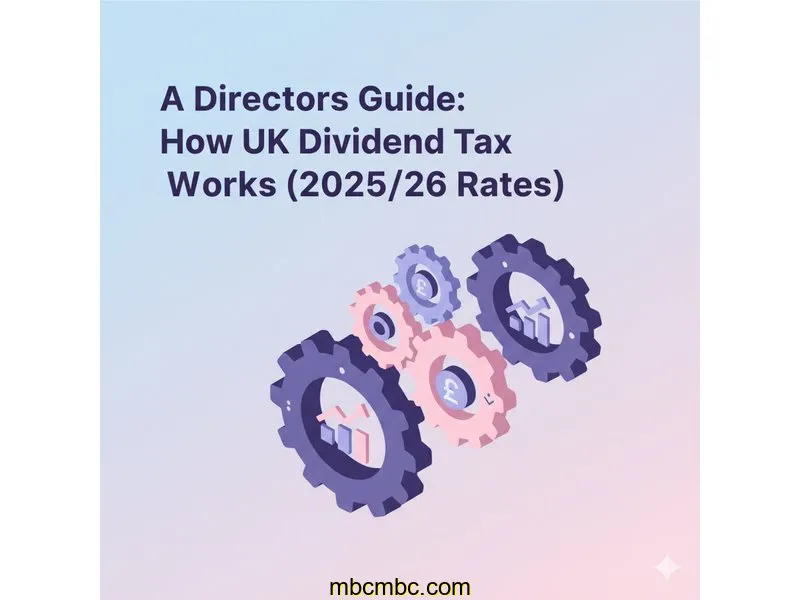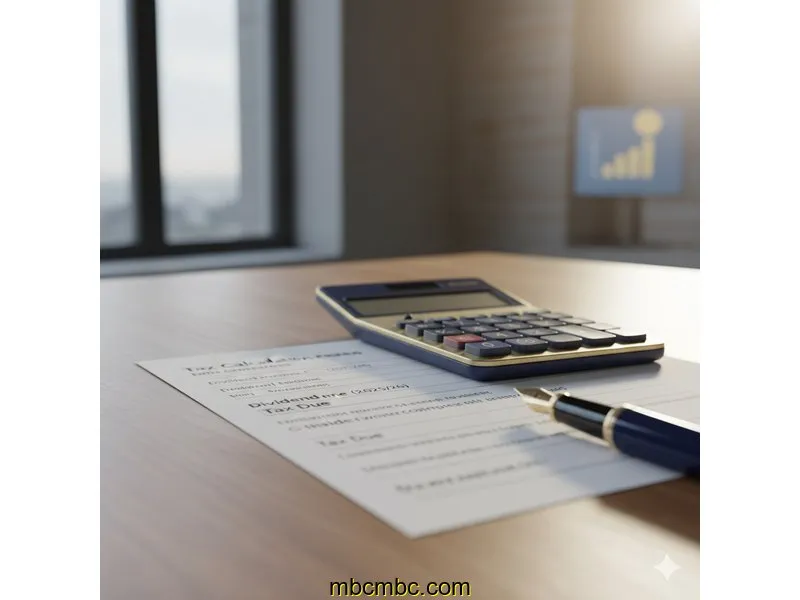
If you're a director of your own limited company in the UK, one of the first and most important concepts you'll encounter is the dividend. It's the primary way many directors take profits out of their business, but it's a world away from the simple PAYE salary you might be used to. Understanding the mechanics is crucial, especially as the rules have tightened.
In recent years, the tax-free 'Dividend Allowance' has been reduced significantly, dropping to just £500 for the 2025/26 tax year. This means that understanding exactly how and when you'll be taxed on your dividend income is more important than ever for managing your personal finances.
This guide is designed to explain the process and the numbers involved. We'll break down how dividends are taxed, how they interact with your personal allowance, and what common pitfalls to be aware of. This is an informational guide to help you understand the system, not financial advice on how you should structure your income.
Quick Summary: Key Dividend Facts
- Post-Tax Profits: Dividends are paid from a company's profits *after* Corporation Tax has been paid.
- No National Insurance: You do not pay any National Insurance contributions on dividend income.
- Tax-Free Allowances: You have a Personal Allowance (e.g., £12,570) for all income and a separate £500 Dividend Allowance (for 2025/26).
- Separate Tax Rates: Dividends are taxed at lower rates than salary income: 8.75% (Basic), 33.75% (Higher), and 39.35% (Additional).
- Self-Assessment: Dividend income (above the allowance) must be declared to HMRC via a Self-Assessment tax return.
What Exactly Is a Dividend (and What Isn't It?)
It's helpful to think of your limited company as a separate legal 'person'. That 'person' earns money and pays its own bills and taxes. Any profit left over belongs to the company. A dividend is simply the company's shareholders (which in a small business, is usually just you) voting to distribute some of that leftover profit to themselves.
This is fundamentally different from a **salary** (including a director's salary). A salary is a payment for your *work*. It's treated as a business expense, which means the company pays it to you *before* it calculates its profit and pays Corporation Tax. In contrast, a dividend is paid *after* Corporation Tax.
It's also crucial not to confuse dividends with a **Director's Loan**. Taking money from the company without formally declaring it as a salary or dividend is a loan. This creates a debt you owe back to the company and comes with a complex set of tax rules and potential penalties if not handled correctly.
The 2025/26 Dividend Tax Rates and Allowances
This is where the numbers come in. When you receive a dividend, you have two key allowances that can reduce your tax bill.
- Your Personal Allowance (£12,570): This is your main tax-free allowance for the year. It gets used up by any income you receive, starting with 'non-savings' income like a salary. If you take a small salary, it will use up some or all of this allowance.
- Your Dividend Allowance (£500): This is a separate, specific allowance just for dividends. The first £500 of dividends you receive in the 2025/26 tax year are 0% taxed, regardless of your other income.
After your allowances are used, any further dividends are taxed based on which Income Tax band they fall into. Your total income (salary, dividends, and anything else) is added up to determine this. However, dividends are taxed using their own special, lower rates.
Here is a breakdown of the rates for the 2025/26 tax year (which starts 6th April 2025).
| Income Tax Band | Total Income Threshold (2025/26) | Dividend Tax Rate |
|---|---|---|
| Personal & Dividend Allowances | First £12,570 (plus £500 for dividends) | 0% |
| Basic Rate | Over £12,570 up to £50,270 | 8.75% |
| Higher Rate | £50,271 to £125,140 | 33.75% |
| Additional Rate | Over £125,140 | 39.35% |
The "Stacking" System: A Clear Example

The trickiest part is understanding how the allowances and bands 'stack' together. Think of your income as filling up a bucket, starting with your salary, then your dividends.
Let's imagine you take a **£12,570 salary** and **£20,000 in dividends**.
- Your **£12,570 salary** uses up your entire **Personal Allowance**. You pay £0 income tax on this.
- Now, you add your **£20,000 in dividends**. Your income 'bucket' is now at £32,570 (which is in the Basic Rate band).
- The first **£500** of your dividends is covered by the **Dividend Allowance**. Tax = £0.
- You have **£19,500** of dividends remaining. All of this falls within the Basic Rate band.
- Your tax bill for dividends is: £19,500 * 8.75% = **£1,706.25**.
This total tax (£1,706.25) would be calculated and paid via your Self-Assessment tax return at the end of the tax year.
How Calculators Help Model Your Dividend Tax
As you can see, the calculation involves several moving parts: your salary, your dividend amount, the allowances, and the tax bands. While the example above is straightforward, it gets complicated if your income tips over the Higher Rate threshold, or if you have other income sources.
This is where a dividend tax calculator becomes an invaluable informational tool. Instead of doing the 'bucket' maths by hand, you can input your different income streams, and the calculator will:
- Automatically apply the Personal and Dividend allowances in the correct order.
- Calculate how much of your dividend income falls into the basic, higher, and additional rate bands.
- Present you with a clear estimate of your total dividend tax bill.
- Show you your final 'take-home' pay after all taxes.
Using a calculator allows you to model different scenarios. For instance, you could see the tax impact of taking £20,000 in dividends versus £30,000. This helps you understand the tax implications of your decisions *before* you make them, which is essential for good financial planning.
The Legal Pitfalls: "Illegal Dividends" and Paperwork
Beyond the tax, there are two critical legal rules to follow. Ignoring them can lead to serious problems with HMRC.
1. Illegal Dividends: You can *only* pay a dividend if your company has sufficient 'retained profit'. This means you must have made more money than you've spent (including salaries, bills, and Corporation Tax). You cannot legally pay a dividend if your company has no profit or has made a loss. Doing so is called an 'illegal' or 'ultra vires' dividend, and HMRC can force you to pay the money back.
2. The Paper Trail: For every dividend you pay (even in a one-person company), you must hold a brief board meeting (even with yourself) to 'declare' it. You must then create and keep two documents:
- Board Minutes: A simple document recording the decision to pay a dividend.
- A Dividend Voucher: A 'payslip' for the dividend, showing the date, company, shareholder's name, and the amount.
This paperwork is a legal requirement and is the first thing HMRC will ask for in an investigation. Skipping this step can create a major headache.
Common Questions About Dividends for UK Directors
Do I have to pay National Insurance on my dividends?
No. This is one of the main differences between a salary and a dividend. Dividends are not subject to National Insurance contributions (neither employer's nor employee's). This is a key reason why a low-salary, high-dividend structure is often explored by company directors.
What's the difference between the Dividend Allowance and the Personal Allowance?
The Personal Allowance (£12,570) is your main tax-free allowance for *all* types of income (salary, interest, dividends). The Dividend Allowance (£500) is a *separate, additional* allowance just for dividend income. It makes the first £500 of your dividends tax-free, even if you've already used your Personal Allowance with a salary. It's also a '0% band' rather than a true deduction, meaning it uses up part of your Basic Rate tax band.
Is it better to take a small salary and large dividends?
This is a common strategy, but what's 'better' depends entirely on your company's profits and your personal tax situation. A small salary (often set at the National Insurance threshold) can be efficient as it's a business expense that reduces Corporation Tax, while also qualifying you for state pension credits. However, with the Dividend Allowance now at only £500, the tax savings are not as significant as they once were. This is a complex area and it's highly recommended to seek formal advice from a qualified accountant. They can analyse your specific situation and advise on the most compliant and appropriate structure for you.
Conclusion: Understanding Your Income
Taking income as a limited company director is far more flexible than being an employee, but it also comes with more responsibility. The 'dividend' route is a powerful tool, but it's governed by its own set of rules, tax rates, and legal paperwork that must be respected.
Understanding the mechanics of how your allowances and tax bands interact—especially with the £500 Dividend Allowance—is the first and most important step. By using informational calculators and ensuring your record-keeping is perfect, you can gain a clear picture of your finances and ensure you're setting aside the right amount for your Self-Assessment tax bill well in advance.

